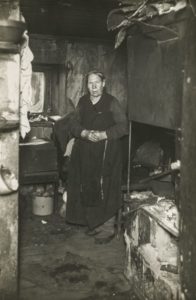Kalamaja Museum’s Exhibition ‘Where Even Sunrays Will Not Reach’ in the courtyard of museum
Hans Soosaar’s photo series of the meeger living quarters of North Tallinn
‘…where even sunrays will not research.’ This is how the photographer and photo journalist Hans Soosaar (1903–1961) described Jüri’s home who lived on Köie Street. As one of the first professional photo journalists in Estonia, Soosaar has been fortunate and unfortunate enough to capture life under various power regimes. His photos can be seen on the columns of Rahvaleht (The People’s Magazine), Noorte Hääl (the Young People’s Voice), the Revaler Zeitung, Rahva Hääl (the People’s Voice) and others. His photo lens has seen the colorful balls of the Estonia Theater, people executed at the Klooga Concentration Camp, but also the simple life in the residential areas during the first Republic of Estonia.
At the end of the 1920s, Soosaar walked on the streets of Kalamaja and Põhja-Tallinn, and recorded the meeger living conditions of Tallinners. It is not known why this photographer, who was just at the beginning of his career, decided to photograph the homes of those with low-income and the unemployed. [1]. Although the press at the time chose to remain silent on issues that would cast a shadow on the image of the young republic, Soosaar fortunately did not follow this tactics of disregard. [2]
On the exhibition You can see 10 photos of Soosaar’s apartment depictive photo series dating back to the 1920s. The photos come with detailed descriptions of the life of the inhabitants, the texts originating from the back of the photos. The exhibition was first seen on the streets of Kalamaja in the autumn 2019. Then the pictures were placed in front of the same houses that Soosaar captured over 90 years ago. Soosaar’s photos, placed on the streets of their homes, brought people living in dreadful and humble conditions out of the shadows into the autumn light. Please take a moment from your day and have a look.
[1] Liibek, Tõnis 2014. Hans Soosaar – a photojournalist from Päts’ time until Khrushchev’s thaw. – Estonian Press Photo, pages 1–7. [2] Linnap, Peeter 2010. On Estonian Photography 1900–1940. – History of Estonian Art 1900–1940. Tallinn: Estonian Academy of Arts.Curator: Laura Jamsja
Consultants: Kristi Paatsi, Aap Tepper, Tuuli Silber
Artist: Lilian Juhkam
Photo sources: Estonian History Museum, Tallinn City Archives, Photo Museum
The exhibition was part of the Tallinn Photo Month ’19 satellite program.
Special thanks goes to:
representatives of the Kalamaja Apartments Association, Sille Kima, Joel Leis, Indrek Hinrikus, Andres Lall, Sirje Pallo, Kadri Toomsalu, Tanel Verk, Anneli Jalava, Jaak Juske.

Kesk-Kalamaja Street 11-6: Edu
“Old lady, lives in a dark, damp basement apartment. Pays 250 marks a month in rent.” (AM _ 16313: 7 F 5900: 7)
Photo descriptions:
1. Köie tn 1a: Jüri
“A crooked old man, living in a totally dark basement where no ray of light can reach. There’s also no lamp, since there’s no money to buy kerosene. The relatives live in the apartment next door, but they don’t take care of the grandfather. The old man gets a small monetary support from the city and is on the list to a retirement home, but they don’t have any rooms, and you cannot go to the home unless someone dies first and through that a room becomes available. The old man goes almost every day to the city welfare department to get news about the issue.” (AM _ 16313: 12 F 5900: 12)
2. Girgensoni/Tööstuse street 26-4: Anna
“Old lady, doesn’t have an apartement. The picture shows some kind of frame covered with a black linen shingle, also filling the place of a “couch“, bed, dining table, etc., and is placed in the cold hallway next to the stairs, in front of the attic door.”
(Description TLA.1465.1.1142, Photo AM _ 16313: 3 F 5900 : 3)
3. Wabriku / Factory 6-46: Madli
“A middle-aged widow, incapacitated for work, has cancer. The child goes very day to kindergarten where the child can get lunch. Room is in a poor condition, in general.” (AM _ 16313: 9 F 5900: 9)
4. Kesk-Kalamaja 11-6: Edu
“Old lady, lives in a dark, damp basement apartment. Pays 250 marks a month in rent.” (AM _ 16313: 7 F 5900: 7)
5. Wõrgu/Võrgu 25-8: Marie
“A dark apartement. It’s a damp, smelly joint next to the laundry room.” (AM _ 16313: 8 F 5900: 8)
6. Küti 15-5: 11-member family
“The family of 11 lives in a tiny, confined space. The man goes to work at the Baltic Cotton Factory. Two older kids are already able to work but because of no jobs available they don´t have work.” (TLA.1465.1.1149)
7. Suur Batarei/Suur-Patarei 10-8: Marie
“80 years old. Warm apartment with a room and kitchen; is dirty. Two young men (co-tenants) living in the kitchen.” (TLA.1465.1.1148)
8. Girgensoni/Tööstuse 4-11: Marie
“37 years old lady. Got typhus at the age of 13 and as a result became insane; the condition has remained the same for 24 years. Tends to get nasty during outbreaks of the illness, that’s why is separated by a net-cage. Rocks her body violently, especially when influenced with nerv convulsions.” (TLA.1465.1.1156)
9. Wäike Batarei / Väike-Patarei 2-7 : Jüri
“Lives in a dark basement apartement, has a broken leg, not able to work due to partial disability (75%). Married. As I overheard, have arguments. The woman goes to work, the man stays at home. Apartment rent 500 per month. Keep co-tenants.”
(AM _ 16313: 6 F 5900: 6)
10. Wäike Batarei / Väike-Patarei 11-7: a 9-member family
“A family of 9 with 7 under-age children, in addition to that one woman with a small child she breastfeeds, living in a small room with a floor area of approx. 4 square fathoms (13,37 m2). The man has occasional work.” (TLA.1465.1.1158)